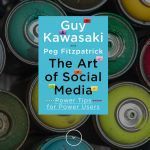Erik Qualman's Blog, page 576
December 9, 2014
Don’t Miss Digital Leadership Hangout

Whether its LinkedIn? Twitter? Or Facebook? Social media in our world today can be a bit intimidating yet very tedious. Although social media success can seem like a test, there are many benefits of being digital. The most compelling digital leaders are acknowledging the benefits of being digital in our world today.
What are the benefits and challenges of leading in a digital age? What specific actions and strategies can leaders take to best engage stakeholders? How can we best use social media in times of crisis? Who at the university should educate students about issues of online citizenship? Should social media become an essential competency for faculty and administrators?
Are you ready to learn about technology and focus on the great possibilities in digital leadership? If so, we invite you to join an episode of SA Live, with host Tony Doody. We are excited to announce our very own author Erik Qualman will be a guest on the Student Affairs Series. Along with Dean of Students Kenn Elmore and Assistant Vice President of Auxiliary Services Dr. Julie Payne-Kirchmeier as they share their journey and insights on leadership, advocacy, engagement and authenticity using social media and technology.
Wednesday, December 10th at 1:00pm ET
Broadcasted over Google Plus, On-Air Hangout
Conversation: #HigherEdLive
http://higheredlive.com/digital-leadership-rockstars/
If you have any questions for our guests send them to #higheredlive during the show and we’ll do our best to incorporate them into the conversation.
[image error]
December 8, 2014
Greek Life Goes Social: Fraternity and Sorority Digital Identity

Fraternities and Sororities are often the hub of campus life and activities at a number of universities. Among the myriad of service, social, educational, and wellness programs that many college campuses enjoy, Greeks Letter Organizations (GLOs) are often the planners and leaders within their groups and other student clubs that drive activities. Many GLOs are strategically increasing digital presence and leveraging social media to increase exposure and build a brand. Part one of my series called “Greek Life Goes Social,” will explore a few unique ways that Fraternities and Sororities are using digital tools to engage their membership, campuses, and communities. Some examples include:
Alpha Phi Alpha Fraternity, Inc., (my fraternity) offers an interactive website and YouTube Channel to share messages from Fraternity Leadership and provide training for local chapters. Other video resources include a webinar to help local chapters develop and execute philanthropic programs and a webinar to help undergraduate members apply for graduate school. Alpha Phi Alpha also has an active Twitter presence, a Facebook page with nearly $35,000 likes and a LinkedIn page.
University of Texas sophomore Ari Gootnick, a member of the Zeta Beta Tau fraternity developed an app that focuses on Greek Life called Greek Link. Gootnick partners with other members of his fraternity to run the app, which is used to communicate Greek Life events and activities and increase interaction among campus GLOs. The Greek Link App can be downloaded in the Apple Store.
Travel, Entertainment, And Marketing, (T.E.A.M.) is a GLO-focused event planning company that offers a thoughtful Social Media Do’s and Don’ts blog post for leaders of campus GLOs. T.E.A.M. advises Fraternities and Sororities that “Online and social media is the fastest growing marketing medium in the business world. Everyone now seems to have a Smartphone and has instant access to information about your chapter and your MEMBERS.”
On my campus, we launched a new Greek Life Blog this semester. Through the blog, our Fraternities and Sororities tell their stories of brother and sisterhood, organization history, campus engagement and community service. This blog content will be helpful for recruitment and sharing some of the positive stories about Greek Life at Indiana University Southeast.
The Association of Fraternity/Sorority Advisors (AFA) uses social media to carry a number of messages about programming, education, and development for Greek Life. Reviewing the twitter conversation about the recent AFA Annual Meeting via their conference hashtag (#AFAAM) will reveal a number of educational opportunities that exist to support and enhance the Greek Life experience on college campuses. The AFA Executive Director, Mark Koepsell actively uses twitter as a tool to communicate about AFA.
Alpha Phi International Sorority offers a robust social media portal on their website which provides a range of digital options to stay connected with the organization. Alpha Phi’s digital portal also includes the Alpha Phi Blog Spot where college members and the national office share updates about the experience, philanthropy, and leadership activities within the sorority.
Kappa Delta Sorority also provides a national social media policy to educate members about effective use of internet, personal websites, promotion, use of the organization name, and guidelines for chat rooms and social networks. Kappa Delta also provides a list of impermissible social media and internet behaviors which includes:
Harassment
Libel or slander
Fraud or misrepresentation
Unauthorized copying or transmission of copyright-protected items
Use of Kappa Delta Sorority’s trademarks, logos, insignia or copyrights without prior approval
Unauthorized use of email accounts or passwords assigned to others
Posting or sending obscene, pornographic or offensive material
Posting or sending political information or propaganda
Material that casts the sorority in an unfavorable light, including, but not limited to, any materials deemed to associate the sorority with alcohol or illegal-substance use or to be sexist or demeaning to minorities or other persons
Posting or sending material that does not comply with the mission or values of Kappa Delta sorority
Solicitation of alumnae for personal reasons or fundraising for personal community-service interests
Fraternities and Sororities lead many campuses in community service, social life, and programs that influence student life on most campuses. In order to keep pace with a changing and more tech-savvy student population, GLOs who leverage digital media to engage and educate their members and campuses are not just ahead of the proverbial game, they are changing it.
Next month, in part two of this series, I will explore how GLOs, campuses, and other organizations leverage digital tools to proactively educate students about the risks associated with hazing.
[image error]
4 Proven Scientific Tips for a Profile Picture that Attracts Men, Women, Jobs

Having an attractive social media profile picture (avatar) is advantageous for both personal and professional reasons. In my recent interview with #1 Best Selling Author Guy Kawasaki he calls this a “duh-ism.” The duh is we all know we need an attractive profile picture (avatar).
He indicates that an attractive avatar does two things. First, it validates who you are, as there may be more than one Erik Qualman. Second, it supports the narrative that you are likeable, competent, and trustworthy. We all know this, duh. But, how do we produce an avatar that attracts people, job recruiters, and new business?
According to Kawasaki the science to producing your best avatar is based heavily on four factors:
Focus on your face: There’s no room for your family, dogs or company logo
Go asymmetrical: Symmetry makes a photo less interesting. Don’t put your face in the middle. Use hypothetical vertical lines to divide your photo into thirds and place your eyes on one of these lines (see Kawasaki’s avatar below)
Face the light: The source of light should come from in front of you
Think big: Upload a photo that is at least 600 pixels wide. While people will most often be scanning your posts and see the postage side image, when they click on one of your posts they will see a crisp, clear and large photo of you. It’s important to have this 600 pixels wide image.

If you follow these simple guidelines then you are well on your way to putting your best face forward on all of your social media profiles. As you can see in the photo above, my avatar violates some of these rules while Kawasaki’s is a picture of perfection. I guess it’s time for me to do another photo shoot! There are over 100 power tips like this one in Guy Kawasaki and Peg Fitzpatrick’s new book The Art of Social Media: Power Tips for Power Users. I highly recommend this book.

This post was originally written by Erik Qualman on LinkedIn.
[image error]
The Science to Having an Attractive Profile Photo on LinkedIn

Having an attractive social media profile picture (avatar) is advantageous for both personal and professional reasons. In my recent interview with #1 Best Selling Author Guy Kawasaki he calls this a “duh-ism.” The duh is we all know we need an attractive profile picture (avatar).
He indicates that an attractive avatar does two things. First, it validates who you are, as there may be more than one Erik Qualman. Second, it supports the narrative that you are likeable, competent, and trustworthy. We all know this, duh. But, how do we produce an avatar that attracts people, job recruiters, and new business?
According to Kawasaki the science to producing your best avatar is based heavily on four factors:
Focus on your face: There’s no room for your family, dogs or company logo
Go asymmetrical: Symmetry makes a photo less interesting. Don’t put your face in the middle. Use hypothetical vertical lines to divide your photo into thirds and place your eyes on one of these lines (see Kawasaki’s avatar below)
Face the light: The source of light should come from in front of you
Think big: Upload a photo that is at least 600 pixels wide. While people will most often be scanning your posts and see the postage side image, when they click on one of your posts they will see a crisp, clear and large photo of you. It’s important to have this 600 pixels wide image.

If you follow these simple guidelines then you are well on your way to putting your best face forward on all of your social media profiles. As you can see in the photo above, my avatar violates some of these rules while Kawasaki’s is a picture of perfection. I guess it’s time for me to do another photo shoot! There are over 100 power tips like this one in Guy Kawasaki and Peg Fitzpatrick’s new book The Art of Social Media: Power Tips for Power Users. I highly recommend this book.

This post was originally written by Erik Qualman on LinkedIn.
[image error]
December 4, 2014
Socializing Your Internet Marketing

 How adept are you when it comes to Internet marketing?
How adept are you when it comes to Internet marketing?
If that is the line of work you specialize in, then you are likely up to speed on how to best market your company’s brand.
Meantime, ff you run your own business but seemingly don’t have time or the funds to hire one or more folks to do Internet marketing, there is a good chance you are missing out on potential revenue.
While some businesses are keyed in to the benefits of Internet marketing, others seem to be a day late and a dollar short. In the latter cases, make the coming New Year the year when you grab Internet marketing by the horns and run with it.
Social Media’s Role
One of the major options at hand for you and your business to capitalize on Internet marketing is social media.
At the end of the day, your company’s goal is to drive as many leads and as much traffic as possible to your site. When you implement social media and know the facts on Internet marketing, good things can happen.
Among the ways to best do this:
Be consistent – First and foremost, any and all social media campaigns need consistency. For example, let’s say you want to run a marketing promotion on Facebook. Are you going to stay on top of it daily or just check in on it periodically? Will you follow through with any prize awards or will you leave contestants hanging? As should be the case with all of your social campaigns, consistency is key;
Be Smart – While there is no doubt a percentage of people on social media that can be told just about anything and they will believe it, a large portion of social networkers are not as dumb as you might think. If you continuously spam them, you’re going to lose a high percentage of them over time. Assuming you want to build loyalty on social media, treat consumers with respect from day one;
Be Authoritative – If you’re seen as an authoritative social source, you will increase the likelihood that consumers will want to learn more about your brand. Part of becoming an authoritative source comes via sharing. Grow your presence on sites such as Twitter, Google+ and Facebook for starters. Sharing relevant links (related to your industry) with others allows your company to be seen more people. As more people become aware of your company, your website traffic should see an uptick;
Be Positive – Last but certainly not least; keep your social media image positive. This can be accomplished in a number of ways, but here are two of the most important. First, avoid negative confrontations with people (customers or non-customers). You gain absolutely nothing from such engagement other than bad publicity. If you’re trying to market yourself to those who are not already customers, engaging in negativity with others lessens your reputation. Secondly, respond positively when someone has something good to say about your products or services on social sites. Whether they are a customer or potential one, people like quality customer service at all times. Something as simple as a tweet or share for a thank you regarding a job well done puts you in a good light.
In conclusion, unless you are paying someone in-house or outside your company loads of money to handle all your social media efforts, using social media as an Internet marketing tool is essentially free.
Sure, time and effort are certainly involved, but social media marketing is an endless universe of benefits for you and your company when done correctly.
Photo Credit: Image courtesy of Stuart Miles at FreeDigitalPhotos.net
[image error]
How Can ‘Word of Mouth’ marketing shape your business?

Marketing is considered to be one of the most understated areas in developing any online business. Along with sales, marketing can come in numerous forms and is vital in driving a brand and ensuring a strong customer based with continuous growth.
Marketing can often be costly and demands both patience and time to ensure a build in brand presence. The rise in social media has no doubt played a large part in modern day brand engagement.
By establishing a ‘conversation’ with brands, consumers are engulfed in a world of constant engagement and emotion. For example, in the UK the current John Lewis Christmas TV advert is a prime example of how marketing can considerably boost the ‘conversation’ of a brand.
The online and offline world are now more closely linked than ever. With the help of social media, word of mouth (WOM) marketing has become a major marketing strategy for global business. The idea of creating a positive message and sending it from person to person is not only highly effective, but can also be very cheap.
Viral content is a prime example of how businesses are implementing both offline and online strategies. Marketing expert, Geno Church explains the main consumer motivations behind creating conversation:
Function – Conversations are generated in order to make agreement and choose what brands are useful and what aren’t.
Social – People converse about brands online to look good and to build up their own sense of reputation.
Emotion - Brands that create immediate reactions are more inclined to be discussed in both online and offline situations.
Church also described how the online and offline work within WOM marketing and their key features:
Online. The more public platform (also, voyeuristic) where people feel they have to show how brilliant, unique and special they are. This is called a ‘discontinuous conversation’ because you can actually decide when to respond, and you have the time to determine how you want to respond (depending on how good you want to look.) This is about making a social connection. Not an emotional one.
Offline. The more personal space, where you have more instantaneous, face-to-face conversations. This is called ‘continuous conversation’ because it is naturally more emotional, more spontaneous, authentic and real.
Below are two case studies in which WOM marketing has been integral to brand success.
Superdry
Considered to be one of the most successful UK fashion brands of the last ten years, Superdry have found themselves in the spotlight when celebrities including David Beckham and Justin Bieber were noticed wearing the brand.
This had a considerable impact on their brand in the US in which the company, founded by Julian Dunkerton, employed a strong marketing presence in the very competitive US fashion market.
ALS
Raising over $100 million, the ALS Ice Bucket Challenge has been by one of the biggest social media influenced charity campaigns ever. Geno Church stated that “emotions trigger passions” which was precisely the case with this example.
The value of WOM marketing can sometimes be unclear and difficult. Marketing was once seen as a way conversation from brand to consumer. However, the conversation is now a much more free-flowing engagement between the two.
[image error]
Holiday Sales Ringing Up Via Social Media

 Many major retailers are relying on social media to attract more customers, keep their current customer base and beat out their competition.
Many major retailers are relying on social media to attract more customers, keep their current customer base and beat out their competition.
A report from Aberdeen Group found that 55 percent of retailers have succeeded in expanding their customer base through social media.
With the holidays here, companies are narrowing in on their social media campaigns and going all-out to beat out competitors and get more customers into their place of business. This is especially true for retailers that sell electronics, as the demand is high and competition is tight.
How to Promote Online
If you’re a retailer looking to use social networking to get your brand out there, consider:
Use photos. Many retailers – such as Walmart, Gap and Nordstrom – use platforms such as Instagram to showcase their best-selling items and attract customers. Snap a photo, link it to the product page and watch the sales ring in;
Host giveaways. JC Penney, for example, wanted to grow their brand during the back-to-school season. They created a scavenger hunt via Facebook and offered rewards to all those who participated. The result? Thousands of consumers wound up liking and following JC Penney on Facebook, which allowed them to achieve their goal and increase brand awareness;
Engage in customers. Retailers know that in order to keep and grow their customer base, they need to engage with them via social media. Walmart is a perfect example of a company that successfully does this. With more than 600,000 Twitter followers, Walmart tweets questions, requests retweets and answers customers questions and concerns. Currently they are offering free layaway, which can be used on products like the 4k tv, and are advertising via Twitter;
Offer holiday tips and tricks.Retailers know that even though shopping is a main event during the holiday season, it’s not the only event. Retailers are offering advice on how to decorate for the holidays on a budget, showcasing gift ideas for various members of the family and offering recipes for holiday treats and meals;
Promote coupons and deals. Over the holidays, everyone is looking for items and gifts that are on sale. Between Black Friday and regular holiday sales, competition is fierce. Use social media to your advantage to promote as many deals as possible. Tweet about discounts, advertise on Facebook, make a Pinterest board of all sale items, and utilize Instagram to showcase your merchandise and more;
Follow competitors. There is absolutely nothing wrong with following your competitors on social media to see what discounts they are offering, what types of promotions they are running, how they interact with customers and so on. Companies – both big and small – can learn from each other by seeing first-hand what similar businesses do. This can help you beat out competitor’s prices, offer better deals and promote yourself more on social media.
The holidays are here and stores are ramping up their social media campaigns.
Retailers – get ready; customers – get to following!
You don’t want to miss these once-a-year deals.
Photo credit: Image courtesy of stockimages at FreeDigitalPhotos.net
[image error]
December 3, 2014
Google’s Latest Algorithm Update Promotes Mobile-Friendly Searching

Does your site pass Google’s mobile-friendly test?
While you were busy shopping for your Thanksgiving turkey Google quietly implemented another algorithm that affects websites that haven’t converted to a responsive (mobile-friendly) platform. If your website is not optimized for mobile traffic, you need to make it a priority. Google is anticipates that 2015 will be the biggest year yet in mobile device searching while desktop searching will continue to decline.
Google hinted of this coming algorithm update, and will be rolling it out globally over the next few weeks. In their ever-increasing efforts to provide users with a better search experience Google created criteria for what defines a site as mobile-friendly and provides a testing tool to determine if sites pass the mobile-friendly test.
Googlebots will use the factors listed below to determine a site’s mobile friendliness:
The content must not be wider than the screen.
Links must not be too close together to make it easy for users to select the right link.
Text must be large enough to read without zooming.
The site must avoid using software for mobile devices, such as Flash, because Googlebots cannot read its content.
Sites must fit content to the screen device, whether smartphone or tablet, so users do not have to scroll horizontally or zoom.
To see if your site passes the mobile friendly test click here.
Of course this is advantageous for site developers and search engine optimizers who will likely experience a surge in business from site owners needing updates. 25 percent of all websites—roughly 74.6 million—are now built on WordPress. To meet the demand of Google’s mobile-friendly compliance developers have created several plugins that enable sites to exhibit a mobile-friendly version, however this option is more of a quick fix. Sites that fully convert to a responsive design will have the advantage over sites that are using plugins.
In addition to creating a Mobile-Friendly Test Tool, Google has also added a new section in the search traffic menu of Webmaster Tools that indicates a site’s Mobile Usability. It surveys usability errors that include touch element closeness, content size, font size, viewport configuration, and flash usage.
[image error]
December 2, 2014
Trade Publications Click with Instagram

 Instagram, everyone’s favorite photo sharing app, is quickly becoming a powerful tool for businesses of all kinds – including trade publications.
Instagram, everyone’s favorite photo sharing app, is quickly becoming a powerful tool for businesses of all kinds – including trade publications.
Whether your trade publication is trying to reach more readers or simply increase its social presence, Instagram can help spread the word one image at a time.
Here are just a few ways Instagram can benefit your trade publication as well as other types of businesses:
Instagram Business Statistics
A picture is worth a thousand words, which is why thousands of businesses across the country and around the world use Instagram for their marketing endeavors.
For starters, Instagram has just more than 200 million active users that not only follow, but also share images from companies of all kinds each day.
As for the business side of the photo app, more than 1,300 companies and major brands use Instagram regularly.
Of those businesses, nearly 30% are Fortune 500 brands like Nike and Starbucks. With numbers like this, you’re probably wondering how your trade publication can benefit from Instagram.
It’s Free. Yes, Free
One of the greatest words in the English language is also one of the major benefits of Instagram.
If you want to post a picture of the cover of your most current trade publication or share images of the trade you represent, Instagram lets you do it for free.
With millions of users turning to Instagram around the clock, this isn’t just free photo sharing, it’s free advertising. As long as you know your target audience and take rich, interesting photos, you can increase your customer outreach without spending a dime.
Insta-Engagement
As the following article shows, a great photo can grab the attention of millions of potential customers, which is exactly how to harness the power of Instagram for your trade publication.
Instagram is all about engagement, so you need to take some time to really figure out how to represent your trade publication in a photogenic way.
Maybe you take a picture of someone reading through your publication in a busy coffee shop. Or, maybe you take a picture of a successful entrepreneur looking out the window of their corner office with a copy of your publication in their hand.
Whichever route you take, just know the right photo will increase engagement tremendously.
Visual Marketing Goes a Long Way
Although print marketing has been the standby for decades, it simply doesn’t hold a candle to the visual image. You can say so much more about your trade publication with a photograph.
For example, instead of explaining the benefits of the trade, you can show a picture of someone working hard in the field. Visual marketing, like the kind Instagram provides, brings your trade publication to life.
Increasing Traffic
Posting a stunning photo and watching your followers increase is just part of the Instagram experience for your trade publication.
By linking to your business, you can increase traffic to your website with every photo you post. Instagram gets people visually interested in what your business has to offer, which results in an increased interest in your trade publication.
When it comes to photographic success, let Instagram help your publication reach new marketing heights.
Photo credit: Image courtesy of Stuart Miles at FreeDigitalPhotos.net
[image error]
Facebook are Bringing Back Their Real Name Policy Regardless of how You Feel About it

Facebook have announced that they intend to move forward with their “real name” policy, which requires users to use their “authentic” name.
The announcement comes after a previous attempt stalled due to strong criticism from the Social Network’s users, resulting in Facebook apologising—a decision they’ve now seemingly reversed.
According to Facebook’s Help Section, here are the rules by which your name must now adhere:
When first reading these rules nothing seems that strange: it makes sense that you can shorten your first name to Bob if your name is Robert, and it allows for certain aliases (which is a result of the previous criticisms Facebook faced over real names), but when you explore a little deeper into this policy it starts to look a little less friendly, and a little more invasive.
Reports have been coming out that Facebook doesn’t actually allow certain names—or that certain names are being flagged up seemingly without reason. For example, Daz is a common shortening of Darren—not allowed; Nikki, a name many Nicola’s like to use—not allowed.
If like Daz and Nikki your name is flagged up you have to prove to Facebook that you are who you say you are, by providing them with actual identification. Such as:
If you don’t feel comfortable providing Facebook with a copy of your passport or driving licence, you can always opt to provide them with the following:
It’s this second list that is facing even more criticism, as many of the documents contain very sensitive data. Facebook recommend disclosing and blacking out any information a user wouldn’t like to share, but a lot of this information is actually what is needed to verify that you are real.
Even if you give over official documents it may not be enough, as blogger Stephen McLeod, noted on his site:
“Even if you’re known by a certain name in your everyday life, you won’t have that alias on official documents that require your legal name. In which case, how on earth are you meant to prove the existence of a nickname?”
The move is being seen by many as a clear signal that Facebook values its advertising potential over its customers as any users of the site choose to use alternative names for many legitimate reasons, such as work—teachers especially.
Sharing information with Facebook
The move also signals a new era of excess sharing of information with Facebook.
A 2013 study by Carnegie Mellon University showed that Facebook users are already unwittingly sharing too much information with Facebook.
According to the study, from 2005 to 2009, users actually decreased the amount of information they shared publicly. However, in December 2009 Facebook changed its default settings and this all changed. Then, in 2011 Facebook introduced the timeline, suggesting that users shared details about their history as well as key moments from their lives and the level of information shared increased yet again.
Many experts believe that many users would share less information if Facebook were clearer about how this information was being used. Facebook currently make a large amount of user data accessible to advertisers and—worryingly—no one is quite sure what they actually withhold.
Facebook do offer the option to opt-out via the Digital Advertising Alliance opt-out but reports have shown that this opt-out only affects your current browser, and deleting your cookies can reverse the opt-out. For users who access Facebook on multiple devices this opt-out will need to be done for each browser initially and possibly many times again when deleting cookies. Additionally, some of the networks who place ads on Facebook have their own opt-out policies. These factors mean it’s unlikely that you’ll be able to keep all of your data private.
Advertising aside, no one can ever be sure of who is viewing their data. In the US for example, the Foreign Intelligence Surveillance Amendment Act (FISAA) allows the US government to request data that may exist within US jurisdiction. Facebook data is such data.
Campbell Williams of Six Degrees Group discussed the way data can be accessed by various international authorities even if you are not a citizen of the given country.
“Which law they [international companies] choose to obey will be governed by the penalties applicable and exigencies of the situation, and in practice the predominant allegiances of the company management.
Those allegiances are likely to be sorely tested by the scope of FISAA, which essentially authorises the mass-surveillance of foreigners outside US territory whose data is within range of US jurisdiction, including data accessible in US clouds. The question that needs to be addressed is whether EU-based businesses and citizens should be prepared to gamble the integrity, security and privacy of their data against the loyalties of managers of US-based companies.”
Conclusion
Chris Morran of The Consumerist blogged about Facebook’s attitude towards data:
“I just want Facebook and others who take part in targeted advertising to admit that it has nothing to do with providing users with something they want. No one comes to Facebook for the ads, no matter how well-tailored they are to a user’s interest.
Targeted ads are about being able to charge a premium to advertisers who want to know exactly who they’re reaching. Unfortunately, in order to do so, Facebook has to compromise the privacy of its hundreds of millions of users.”
If Facebook are unwilling to make all of their intentions clear, why should a user hand overt so much data just to prove their “authentic” name?
[image error]







